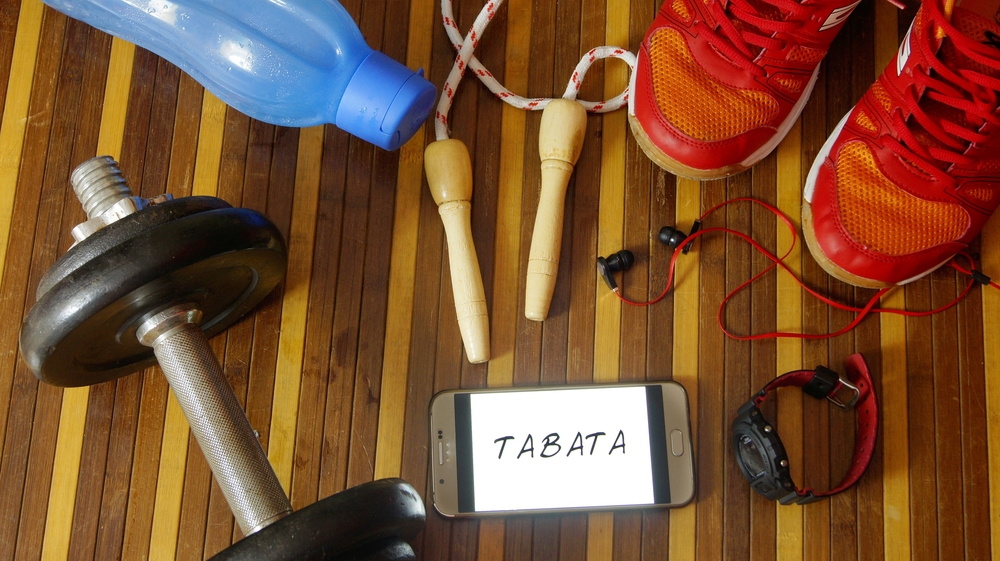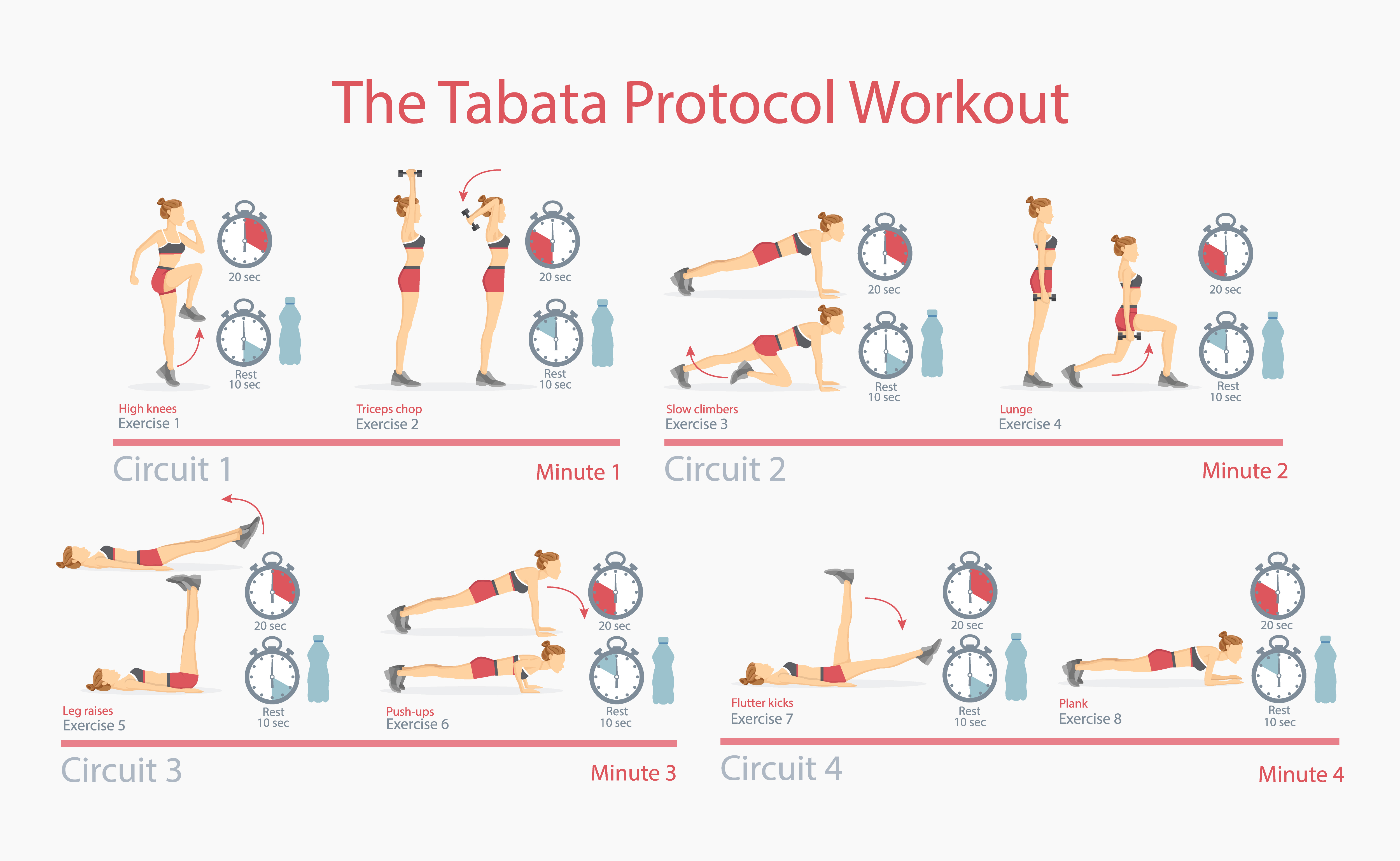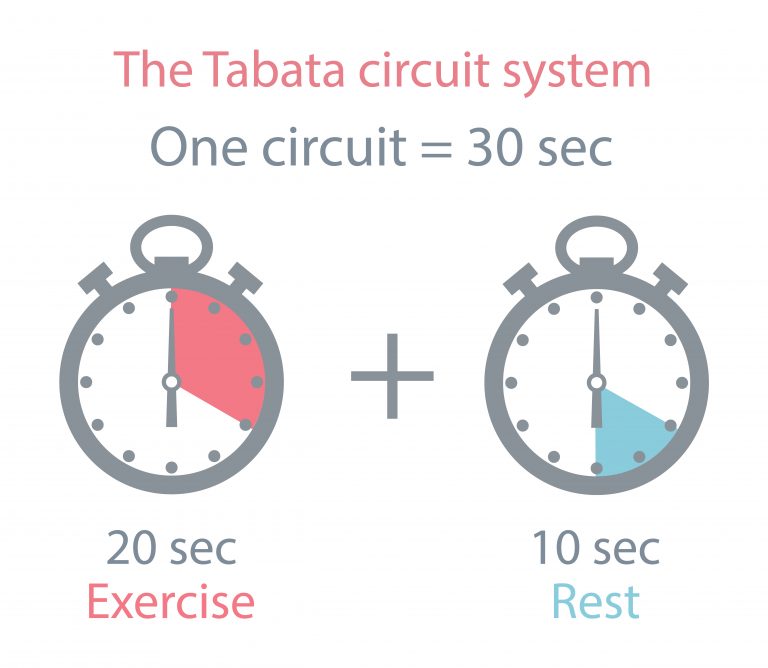Tabata training is a must-have in improving your gym performance and reducing the necessary body fat. It also helps to improve efficiency and speeds up the daily metabolic rate. And all this only in 4 minutes. Tabata is a very popular and well-liked workout among athletes of all disciplines, bodybuilders and amateurs of physical recreation. It saves on days when we happen to indulge in diet and stimulate a slow metabolism. It stimulates the heart and nervous system to work, and all that in just 4 minutes.
Tabata - what is it actually?
Tabata is a specific exercise training, consisting of performing 20-second exercises of high intensity with short 10-second intervals. The whole lasts exactly 4 minutes.
The main feature of Tabata training is its intensity and very short duration. It’s great for busy people who cannot use the gym or are forced to leave the training or simply want to increase the calorie deficit on the diet. It’s also successfully used as one of several sessions of intervals, because it’s very intense and works on the same principle, extremely stimulating metabolism.
It’s carried out using a ready template. For 20 seconds, we make the maximum number of repetitions of a given exercise, 10 seconds rest and again for 20 seconds we give our best, another 10 seconds rest, and so on a total of 8 times. The whole is to last 4 minutes. There is an application called "Tabata timer", which automatically measures the time for activity and rest with appropriate sound signals. A website with music was created especially for the Tabata training, where the appropriate musical insertions and voice in the background tell us at what point we are.
Although Tabata may seem like a great long-distance solution for excuses and training laziness, you should not base your training plans on it. High level of heart rate during the session and high energy consumption does not allow for everyday use as a basic exercise.
There are several basic assumptions for Tabata:
- High intensity - within 20 seconds of work, as many repetitions as possible with as much intensity as possible (max. HR of 80-95%) should be performed.
- Rest between exercises - rest should be intended for deep breaths regulating the circulatory system and changing the station or device, if we use them.
- Multi-joint exercises - explosive exercises involving many muscle parties and using instruments should be selected for Tabata.
- A maximum of 3-4 times a week - Tabata training should be performed as often as it allows us for the condition and level of advancement. However, more often than 3-4 times a week (for advanced) and never in combination with strength training or other activities. Beginners should start from one session a week and gradually increase their number depending on how the blood system reacts and how intense the body regeneration is.
- Appropriate rest - after Tabata session you should rest properly, so that the body can restore homeostasis and repair the damage (microdamage of the muscles, blood circulation, hormonal regulation, energy consumption). Only advanced people in training may be tempted to combine Tabata sessions with strength training, but only with medium or low intensity training. A 4-minute metabolic workout performed on the day of breaking the race or strength records may worsen the regeneration and even lead to overtraining and irreversible damage in the nerve cells.
Tabata is a great solution for people on reducing fat, whose priority is to create a negative caloric balance during the day and stimulate metabolism. It also helps people whose metabolic rate is significantly reduced by various diseases or conditions and lifestyle.

Tabata - exercises
Tabata training is mainly suitable for ballistic (explosive) exercises, multi-joint (involving a lot of muscle parts) and the use of devices such as: barbell, kettlebell, skipping rope or pull-up bar.
Example exercises:
- Jumping rope
- Barbell press - that is, lifting the barbell from the ground from the squat position, squeezing it to the chest and pushing it over the head with the stabilization of the position through muscle tension. You should choose the right weight, but also not too big to be able to do the rest of the exercise.
- Ballistic push-ups - they consist of leaping after making a push-up and landing “softly in the previous position.
- Jumping onto the platform - wonderful ballistic exercises that increase the explosive power of leg muscles. Standing in front of the platform set at a height corresponding to our ability to leap (about 50-60 cm on average), we jump from the semi-squat position and we land on the platform with both legs quickly dropping to the starting position or going down without a jump. It’s important to keep the time between the return and landing as short as possible.
- Kettlebell - standing in a slight strut and holding a rather heavy kettlebell in both hands, loosely between the legs, take a swing from the bottom and throw the weight with the force of the whole body (the energy has to come out of the hips) in front of you to the height of the forehead. We take another swing and throw it up again. It’s important to work with the entire body and muscular corset, and not just waving your hands.
- Pull-ups on wheels or on the bar - they can be performed on Olympic rings as CrossFit fans do, or on a regular pull-up bar. You can pull yourself up with a snap, with a handle, in a neutral grip, depending on your preferences and the parts you want to train (undercling - back and biceps, plateau - back, four-sided, neutral - back).
- Burpees - i.e. squat jump, descent to the push up, back to squat and jump again.
- push press - this is an exercise similar to barbell press, but in this case the barbell rests all the time based on the hands above the chest and the proper movement is her energetic ejection above the head, preceded by a gentle bend of the knees and using the strength of the whole body for the toss.
- Mountain climber - this is an exercise for a little less advanced, but also making us work hard. Adjust to the push-up position, lower the hips to form one line with the body axis and perform alternate knee motions, pulling them to the chest.
- Hitting the sack - one of the better options for use in Tabata. It’s worth using your hands mainly to move your blows as fast and as hard as possible.
- jumps in the plank - place yourself in the push-up position (on the hands, not the forearms) and take a jump forward on slightly bent legs, all the time remaining in the position of the push-up, lifting only the hips for the needs of hip movements.
- Dynamic lunges - we set ourselves in the stride position and with a dynamic movement we jump over the other leg to the next step. All this should be done in one place and with a properly upright posture.
- Sprint in place - the right exercise for people who do not have access to the equipment must be performed with maximum intensity. For variety, you can take dumbbells or put weights on your wrists and perform small boxing.
- Rolling tire / weight - if you have access to an old tire or heavy bag, we can use it for rolling on the ground or pushing. Condition - the weight must be very large, so that one transfusion is associated with a lot of effort.
- Walking on hands - an option for more advanced people, it’s important that it’s performed with the appropriate safety rules and fast enough that a significant effort is felt.
As you can see there are many exercises, their amount is limited only by creativity and access to devices. If we are beginners, we should choose exercises without additional weights and over time add one or two exercises with additional load.

Tabata - effects
The best effects Tabata training will bring in the area of improving the metabolic rate, enhancing the psychophysical condition, and adapting the nervous system to a quick and intense effort. It will also stimulate fast twitch fibres (which are the most important for strength sports fans), especially if we choose explosive exercises like jumps, leaps and strides.
The training itself has no direct effect on fat burning, but it also increases the basic metabolic rate, which in the long run increases the negative balance of calories and supports the diet. This training is also great for runners and sprinters, for whom fitness and endurance are an important element. Such a short workout combined with running, greatly supports the endurance of the muscles and the runner's efficiency allowing for the introduction of exercises strengthening the whole body in its training plan.
However, there are contraindications to Tabata and they are:
- Significant defects of the heart and of the respiratory and circulatory system.
- Significant fluctuations in blood pressure - including very low blood pressure and very high blood pressure.
- Very low activity level every day - if you are just starting an adventure with any sports, you should first prepare a cardiovascular system for increased oxygen uptake and anaerobic work.
- Thrombosis, pulmonary embolism and other serious diseases that do not allow increased effort and work at high heart rates.
Tabata - summary
Tabata is a great workout for busy people, but also for those who like to give themselves a hard workout. It should be remembered not to do it on days spent on weight training with a load. If we have to combine these two trainings in one day, let's distance them from each other temporarily and reduce the intensity at the gym accordingly. Correctly and regularly carried out - Tabata gives great effects in the aspect of improving the rate of energy use, improving the efficiency of the body and increasing endurance.






